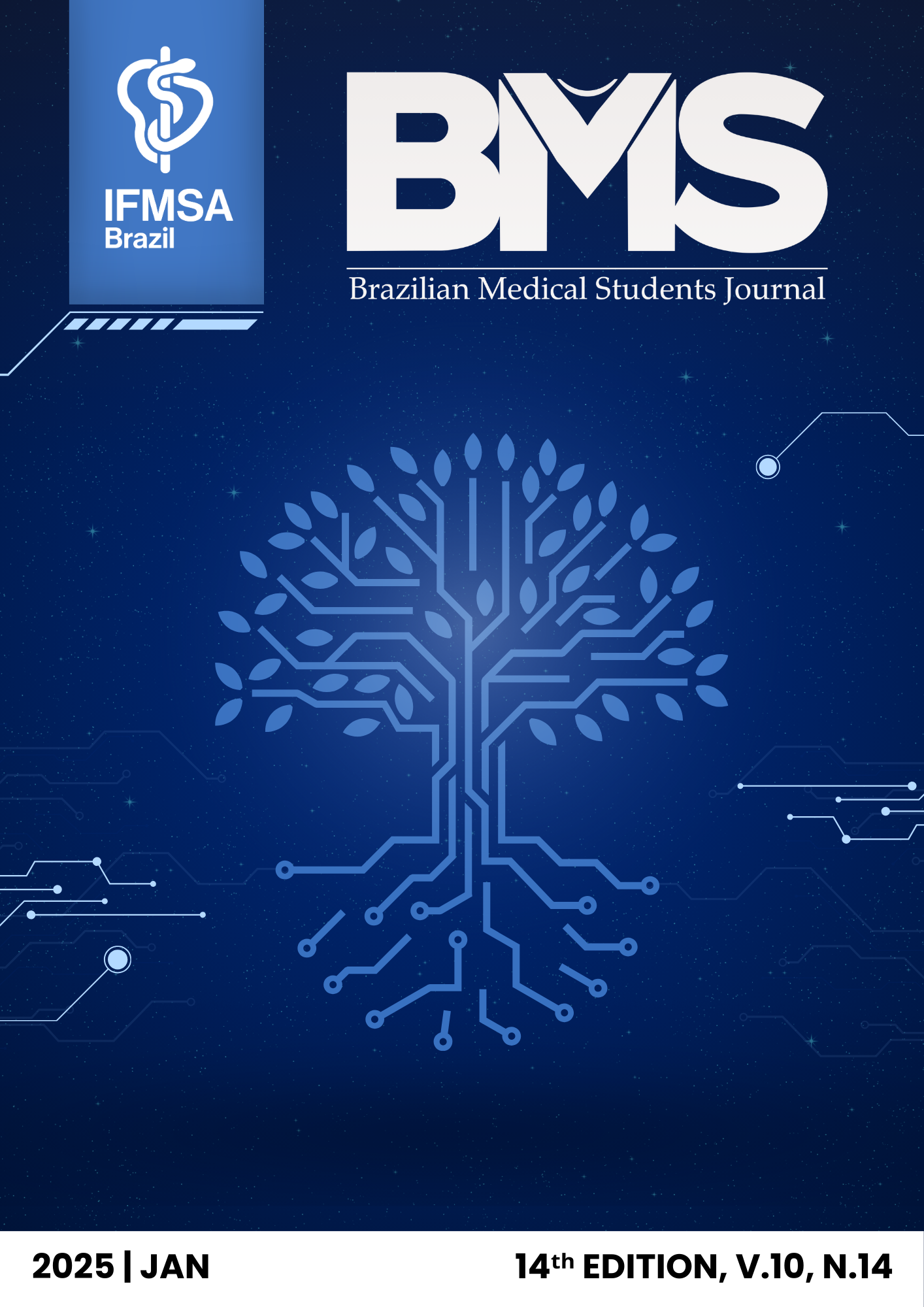EPIDEMIOLOGICAL PROFILE OF TUBERCULOSIS IN THE CARIRI REGION OF CEARÁ BETWEEN 2009 AND 2018
Keywords:
Mycobacterium Tuberculosis, Epidemiology, Cariri Region, temporal trendsAbstract
INTRODUCTION: Tuberculosis remains one of the main public health problems. Despite the expressive number of epidemiological studies dedicated to tuberculosis, the scientific literature still presents significant gaps regarding the incidence of the disease, especially in the southern region of the state. Thus, the present study aims to outline the epidemiological profile of tuberculosis in the Cariri Planning Region of Ceará. METHODOLOGY: An analysis was conducted of the records of new confirmed cases of tuberculosis from 2009 to 2018 in the Cariri Planning Region, made available by the Department of Information and Informatics of the Unified Health System. To assess temporal trends, the data were modeled using Prais-Winsten regression. Subsequently, the Annual Percent Change (APC) was calculated, which estimates, as a percentage, the annual increase or decrease in TB incidence rates in cities and by age group. RESULTS: From 2009 to 2018, 2,223 cases of tuberculosis were confirmed in the Cariri Planning Region. The disease predominantly affected men, individuals with lower education levels, and residents of urban areas. A declining trend in incidence was identified in the cities of Campos Sales (APC = -20.1%, p<0.05), Aurora (APC = -16.9%, p<0.05), Lavras da Mangabeira (APC = -12.3%, p<0.05), and Jardim (APC = -10.5%, p<0.05) and age groups, especially among children and women. DISCUSSION: The results suggest a pattern of increasing incidence with age and a greater vulnerability of disadvantaged socioeconomic groups. The decline in incidence in some age groups may be related to the success of vaccination programs and greater access to health services by women. CONCLUSION: Although tuberculosis is relatively controlled in the region, the continuity of public policies to further reduce the incidence of the disease, especially among vulnerable groups, is essential.
References
Olmo-Fontánez AM, Turner J. Tuberculosis in an aging world. Pathogens. 2022;11(10):1101. doi: 10.3390/pathogens11101101.
de Paiva JPS, Magalhães MAFM, Leal TC, et al. Time trend, social vulnerability, and identification of risk areas for tuberculosis in Brazil: An ecological study. PLoS One. 2022;17(1):e0247894. doi: 10.1371/journal.pone.0247894.
Instituto de Pesquisa e Estratégia Econômica do Ceará (IPECE). As Regiões de Planejamento do Estado do Ceará. Texto para Discussão, nº 111. Fortaleza: IPECE; 2015. Disponível em: https://www.ipece.ce.gov.br/wp-content/uploads/sites/45/2014/02/TD_111.pdf. Acesso em 8 jun 2024. p. 4.
Ministério da Saúde. Tuberculose - Casos confirmados e notificados no Sistema de Informação de Agravos de Notificação - Brasil. DATASUS - Departamento de Informática do SUS. Brasília: Ministério da Saúde; 2023. Acesso em 8 jun 2024. Disponível em: http://tabnet.datasus.gov.br/cgi/tabcgi.exe?sinannet/cnv/tubercce.def
Ministério da Saúde (BR). População residente - Brasil. DATASUS - Departamento de Informática do SUS. Brasília: Ministério da Saúde; 2023. Acesso em 8 jun 2024. Disponível em: http://tabnet.datasus.gov.br/cgi/deftohtm.exe?ibge/cnv/popsvsbr.def
Andrade FRD, Antunes JLF. Time and memory in time series analysis. Epidemiol Serv Saúde. 2023;32(1):e2022867. p. 1.
Silva VR, Pacheco ES, Cardoso OO, Lima LH, Rodrigues MTP, Mascarenhas MDM. Temporal trend of COVID-19 incidence and mortality rates and their relationship with socioeconomic indicators in the state of Piauí, Brazil: an ecological study, 2020-2021. Epidemiol Serv Saúde. 2022;31:e20211150. p. 3.
Pereira A, Hillesheim D, Silva FM, Valim RCS, Hallal ALC. Historical series of tuberculosis incidence in the state of Santa Catarina, Brazil: analysis of a decade, 2010-2019. Epidemiol Serv. Saúde (preprint). 2022. p. 8.
Antunes JLF, Cardoso MRA. Using time series analysis in epidemiological studies. Epidemiologia Serviços Saúde. 2015;24(4):565-76. p. 572.
Google LLC. Google Sheets. 2020. Disponível em: https://docs.google.com/spreadsheets/create.
RStudio Team. RStudio: Integrated Development for R. 2020; Disponível em: https://posit.co/
Mohr FX. Prais-Winsten Estimator for AR(1) Serial Correlation. R package version 1.1.2. 2020. Available from: https://cran.r-project.org/package=prais
MapChart. Brazilian municipalities map. Map of municipalities in the Cariri Planning Region. 2019. Available from: https://www.mapchart.net/brazil-municipalities.html. Acesso em 6 de julho de 2024.
Cabral et al. Tuberculose. Boletim Epidemiológico. Ceará: Secretaria da Saúde do Ceará; 30 mar 2024. Disponível em: https://www.saude.ce.gov.br/wp-content/uploads/sites/9/2018/06/BOLETIM-TUBERCULOSE-2024.pdf. Acesso em 15 de julho de 2024.
Busatto GF, et al. Tuberculose 2024. Boletim Epidemiológico, março 2024. Disponível em: https://www.gov.br/aids/pt-br/central-de-conteudo/boletins-epidemiologicos/2024/boletim-epidemiologico-tuberculose-2024/view. Acesso em 15 de julho de 2024.
IBGE - Instituto Brasileiro de Geografia e Estatística. Panorama do Censo 2022. Rio de Janeiro: IBGE; 2022. Disponível em: https://censo2022.ibge.gov.br/panorama/?utm_source=ibge&utm_medium=home&utm_campaign=portal. Acesso em 16 de julho de 2024.
Silva TC, et al. Fatores associados ao retratamento da tuberculose nos municípios prioritários do Maranhão, Brasil. Ciência Saúde Coletiva. 2017;22(12):4095-4104. Disponível em: https://www.scielo.br/j/csc/a/7t64fZcXnnYt5K8PQjsQCWN/.
Arroyo LH, et al. Identificação de áreas de risco para a transmissão da tuberculose no município de São Carlos, São Paulo, 2008 a 2013. Epidemiol Serv Saúde. 2017 Jul;26(3):525-34. Disponível em: https://www.scielo.br/j/ress/a/HK4j9HxybdqZyhfHWvSfL7q/?lang=pt.
IBGE - Instituto Brasileiro de Geografia e Estatística. Ceará | Panorama. Rio de Janeiro: IBGE; 2023. Disponível em: https://cidades.ibge.gov.br/brasil/ce/panorama. Acesso em 31 de julho de 2024.
Downloads
Published
How to Cite
Issue
Section
License
Copyright (c) 2025 José Geraldo De Souza Silva Gonçalo

This work is licensed under a Creative Commons Attribution 4.0 International License.
User licenses define how readers and the general public can use the article without needing other permissions. The Creative Commons public licenses provide a standard set of terms and conditions that creators and other rights holders can use to share original works of authorship and other material subjects to copyright and certain other rights specified in the public license available at https:// creativecommons.org/licenses/by/4.0/deed.pt_BR. Using the 4.0 International Public License, Brazilian Medical Students (BMS) grants the public permission to use published material under specified terms and conditions agreed to by the journal. By exercising the licensed rights, authors accept and agree to abide by the terms and conditions of the Creative Commons Attribution 4.0 International Public License.


